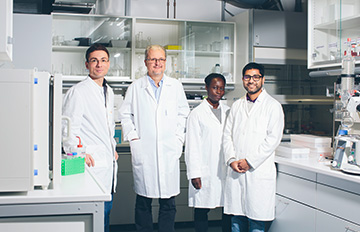![]()
A “stealth” coating allows upconverting nanoparticles to potentially travel through the body undetected by the immune system. The surface has been cross-linked by UV radiation (enlarged image section) and is therefore stable in biological systems. [Image: HZDR / Sahneweiss / istockphoto.com / Thomas-Soellner / Molekuul]
A team of researchers in Germany and Australia report using photopolymerization to coat upconverting nanoparticles (UCNPs) with a “stealth cap” that increases nanoparticle stability and biocompatibility. The work, the researchers believe, could increase the usefulness of UCNPs in medical applications (Angew. Chem., doi: 10.1002/anie.201811003).
Results from in vitro demonstrations showed that the UCNPs with the hydrophilic cap maintain photoluminescence when submerged in water, do not interact with biomolecules in human blood serum, and are also capable of carrying other molecules, like drugs or radioactive labels, within the cap via bioconjugation. The researchers, led by Holger Stephan of Helmholtz-Zentrum Dresden-Rossendorf (HZDR), Germany, say these stealth qualities could someday prove useful in targeted drug delivery for cancer treatment and biomedical imaging.
Traveling incognito through the body
UCNPs are of great interest for biomedical imaging because they absorb infrared (IR) light, which is typically safe for the human body, and convert it into detectable, tunable ultraviolet (UV) and visible light signals. However, UCNPs are usually produced with a hydrophobic oleate coating. This hydrophobic coating repels water molecules, which prevents the UCNPs from traveling unencumbered throughout the body (which is more than 50 percent water by weight).
The HZDR team solved this problem by synthesizing a hydrophilic cap for UCNPS that can in principle allow the particles to travel more freely within biological systems. The method begins by replacing the oleates on the surface with low-molecular-weight diacetylenes (DAs). Next, the researchers overcoat the DA layer with mixed-diyne phospholipids, and then crosslink the entire assembly using UV irradiation. This creates a hydrophilic polydiacetylene (PDA) coating with a neutral surface charge that prevents biomolecules from sticking to the UCNPs as they move through the body.
The combination of a hydrophilic cap and surface-charge neutrality are, as the researchers put it, “excellent stealth characteristics” that could make the UCNPs nearly unrecognizable by the body’s immune system.

Left to right: Kristof Zarschler, group leader Holger Stephan, Anne Nsubuga and Tanmaya Joshi from Helmholtz-Zentrum Dresden-Rossendorf, Germany. [Image: HZDR / O.Killig]
In vitro demonstrations
The researchers demonstrated UCNP fluorescence by exciting the particles with IR light. They recorded emissions between 550 nm and 750 nm, with a maximum emission at 625 nm, and found that the UCNPs only lost a small amount of luminescence intensity when submerged in water.
To test the surface-charge-neutrality “invisibility cloak,” the researchers incubated UCNPs with and without the PDA coating in human blood serum at 37 °C for one hour. Results from gel electrophoresis showed that the PDA-coated UCNPs had almost no biomolecules from the serum adhered to their surfaces, while the uncoated UCNPs picked up a substantial amount of biomaterial.
The team also discovered that the phospholipid overcoat gave the UCNPs’ surface-exposed amino groups to which other molecules—for example, radioactive labels or drugs—could be attached using bioconjugation methods. To demonstrate the ability to stow away molecules of interest, the researchers successfully tethered a radioactive copper label to the surface of the UCNPs.
The HZDR team says that results from these preliminary demonstrations are encouraging, and the researchers hope to further investigate their UCNPs with in vivo studies.
[Correction: Updated 30 November, 9:05 a.m. Eastern U.S. time, with minor edits to clarify the process used to create the UCNP’s hydrophilic cap.]
